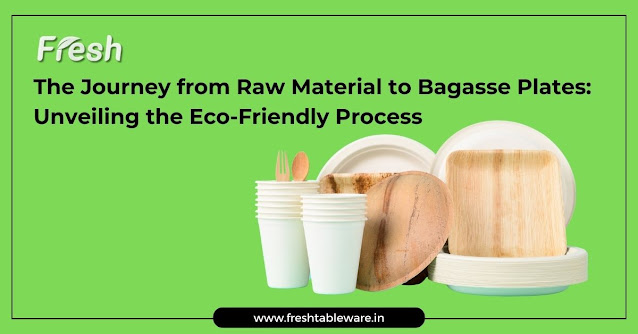The Positive Impact of Biodegradable Tableware on Nature
Biodegradable tableware revolutionizes dining practices by offering eco-friendly alternatives that positively impact the environment. Unveil the sustainable advantages of these products, from their natural decomposition process to their role in reducing plastic waste. Discover how embracing bagasse tableware aligns with eco-conscious initiatives, promoting a healthier ecosystem. Explore the convenience and environmental benefits as these products pave the way for a greener, more sustainable future.
Environmental Friendliness: Biodegradable tableware is made from eco-friendly materials like sugarcane or bamboo, reducing reliance on non-biodegradable plastics.
Natural Decomposition: These products decompose naturally, minimizing landfill waste and significantly reducing environmental impact.
Reduced Plastic Usage: By opting for biodegradable alternatives, the use of non-biodegradable plastics diminishes, alleviating pollution and preserving ecosystems.
Promoting Sustainability: Embracing biodegradable tableware aligns with eco-conscious efforts, promoting sustainable practices and a healthier planet.
Convenience without Compromise: These alternatives offer comfort while ensuring minimal environmental harm, striking a balance between usability and ecological responsibility.
Embracing Sustainability: Sugarcane Plates
Exploring the Eco-Friendly Nature of Sugarcane-Based Tableware
Sugarcane plates, also known as bagasse plates, are revolutionizing the concept of disposable tableware by offering a sustainable alternative. Derived from the fibrous remains of sugarcane after juice extraction, these plates embody eco-friendliness from their very roots.
The process involves collecting sugarcane pulp, which is then moulded and pressed into various shapes to create sturdy and versatile tableware. This transformation of agricultural waste into usable products significantly reduces environmental impact.
Sugarcane-based tableware stands out for its biodegradability and compostability. Once discarded, these plates decompose naturally, returning to the earth without leaving harmful residues or contributing to landfill waste.
The Evolution of Biodegradable Tableware: Sugarcane Plates Unveiled
The journey of biodegradable tableware, particularly sugarcane plates, marks a significant shift in consumer preferences towards eco-conscious alternatives. From conventional plastic and Styrofoam plates that pose severe environmental threats to the emergence of sustainable options, this evolution reflects a growing commitment to reducing ecological footprints.
Sugarcane plates have undergone substantial innovation in recent years. Their design and durability have improved, making them a practical choice for various culinary uses. These plates now come in a range of shapes and sizes, catering to diverse dining needs while upholding sustainability principles.
Understanding the Environmental Benefits of Sugarcane-Based Tableware
The environmental benefits of sugarcane-based tableware are multifaceted. Firstly, the raw material—sugarcane bagasse—is a byproduct of sugar production, utilizing what would otherwise be considered waste. This significantly minimizes agricultural waste and supports a circular economy.
Moreover, the production process of sugarcane plates requires less energy compared to traditional plastic manufacturing, leading to reduced carbon emissions. Their biodegradability ensures they break down naturally, avoiding the long-term pollution caused by plastic disposables.
In addition, the use of sugarcane-based tableware encourages a mindset shift toward sustainability. By choosing these eco-friendly alternatives, individuals and businesses contribute to preserving natural resources and mitigating the harmful effects of non-biodegradable materials on the environment.
Sugarcane plates exemplify a remarkable fusion of innovation, sustainability, and practicality. Embracing these eco-friendly alternatives isn't merely a choice but a step towards a greener, more sustainable future.
Bagasse Plates: Redefining Eco-Conscious Dining
Unveiling the Green Revolution: Bagasse Plates in Sustainable Dining
The introduction of bagasse plates marks a pivotal moment in the quest for sustainable dining practices. Derived from sugarcane pulp, these plates epitomize innovation by transforming agricultural waste into functional and environmentally friendly tableware.
Bagasse plates serve as a testament to the green revolution, offering a viable alternative to traditional disposable plates made from harmful materials like plastic or Styrofoam. They are biodegradable, compostable, and do not pose the environmental threats associated with non-biodegradable options.
Bagasse Plates: A Revolutionary Solution to Reduce Environmental Footprint
The utilization of bagasse plates embodies a revolutionary solution to combat the increasing environmental footprint of disposable tableware. By opting for bagasse plates, individuals and businesses actively participate in reducing landfill waste and cutting down on the consumption of non-renewable resources.
These plates are not only eco-friendly but also versatile and sturdy, suitable for various culinary purposes. Their resilience to heat and liquids makes them a practical choice for both hot and cold foods, meeting the demands of eco-conscious consumers without compromising on functionality.
The Rise of Bagasse Plates: Reshaping Sustainable Dining Practices
The ascent of bagasse plates signifies a transformative shift in sustainable dining practices. Restaurants, catering services, and households alike are embracing these plates as a statement of their commitment to environmental stewardship.
The growing popularity of bagasse plates is reshaping consumer perceptions and behaviours toward single-use disposables. Their presence in the market emphasizes the increasing demand for eco-friendly alternatives that prioritize sustainability without sacrificing convenience.
Bagasse plates stand as a symbol of innovation, sustainability, and responsible consumerism. Embracing these plates in everyday dining isn't just a trend; it's a conscientious choice to contribute to a healthier planet and redefine the way we approach disposable tableware.
The Era of Use and Throw Plates: Environmental Implications
Dissecting the Environmental Impact of Use and Throw Plates
The prevalence of Use and Throw plates has ushered in a convenience-driven culture but has also brought forth concerning environmental implications. These plates, typically made from non-biodegradable materials like plastic or polystyrene, contribute significantly to environmental degradation.
The lifecycle of these plates involves the extraction of finite resources, energy-intensive manufacturing processes, and their ultimate destiny—a lengthy decomposition period that extends beyond generations. Their improper disposal often leads to clogged landfills and marine pollution, posing serious threats to ecosystems and wildlife.
Use and Throw Plates: Balancing Convenience with Environmental Responsibility
The convenience offered by Use and Throw plates is undeniable, catering to quick and hassle-free dining experiences. However, the convenience factor should be balanced with the pressing need for environmental responsibility.
It's essential to strike a balance between convenience and sustainability. Exploring alternative materials or transitioning to biodegradable options, like sugarcane or bagasse plates, can significantly reduce the adverse impact of disposable tableware on the environment without compromising ease of use.
Reimagining Disposable Tableware: Navigating the Sustainability of Use and Throw Plates
The sustainability of disposable tableware, particularly Use and Throw plates, requires a paradigm shift in consumer choices and industry practices. Rethinking the design, materials, and end-of-life management of these plates can pave the way for a more sustainable future.
Innovations in material science offer promising alternatives that balance convenience with eco-friendliness. Compostable materials derived from plant-based sources present an opportunity to reimagine disposable tableware. Embracing these materials encourages a circular economy where the lifecycle of tableware aligns with natural processes, minimizing environmental harm.
The era of Use and Throw plates necessitates a critical reflection on our consumption patterns and their ramifications on the planet. By fostering a culture of responsible consumption and advocating for sustainable alternatives, individuals and industries alike can contribute to mitigating the environmental impact of disposable tableware.



Comments
Post a Comment